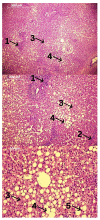Alcohol, Inflammation, and Microbiota in Alcoholic Liver Disease
- PMID: 36835145
- PMCID: PMC9966185
- DOI: 10.3390/ijms24043735
Alcohol, Inflammation, and Microbiota in Alcoholic Liver Disease
Abstract
Alcoholic liver disease (ALD) is a consequence of excessive alcohol use. According to many studies, alcohol represents a significant socioeconomic and health risk factor in today's population. According to data from the World Health Organization, there are about 75 million people who have alcohol disorders, and it is well known that its use leads to serious health problems. ALD is a multimodality spectrum that includes alcoholic fatty liver disease (AFL) and alcoholic steatohepatitis (ASH), consequently leading to liver fibrosis and cirrhosis. In addition, the rapid progression of alcoholic liver disease can lead to alcoholic hepatitis (AH). Alcohol metabolism produces toxic metabolites that lead to tissue and organ damage through an inflammatory cascade that includes numerous cytokines, chemokines, and reactive oxygen species (ROS). In the process of inflammation, mediators are cells of the immune system, but also resident cells of the liver, such as hepatocytes, hepatic stellate cells, and Kupffer cells. These cells are activated by exogenous and endogenous antigens, which are called pathogen and damage-associated molecular patterns (PAMPs, DAMPs). Both are recognized by Toll-like receptors (TLRs), which activation triggers the inflammatory pathways. It has been proven that intestinal dysbiosis and disturbed integrity of the intestinal barrier perform a role in the promotion of inflammatory liver damage. These phenomena are also found in chronic excessive use of alcohol. The intestinal microbiota has an important role in maintaining the homeostasis of the organism, and its role in the treatment of ALD has been widely investigated. Prebiotics, probiotics, postbiotics, and symbiotics represent therapeutic interventions that can have a significant effect on the prevention and treatment of ALD.
Keywords: alcohol; alcoholic hepatitis; inflammation; microbiota.
Conflict of interest statement
The authors declare no conflict of interest.
Figures




Similar articles
-
Alcohol, microbiome, life style influence alcohol and non-alcoholic organ damage.Exp Mol Pathol. 2017 Feb;102(1):162-180. doi: 10.1016/j.yexmp.2017.01.003. Epub 2017 Jan 7. Exp Mol Pathol. 2017. PMID: 28077318 Review.
-
Microbiome-Based Metabolic Therapeutic Approaches in Alcoholic Liver Disease.Int J Mol Sci. 2022 Aug 6;23(15):8749. doi: 10.3390/ijms23158749. Int J Mol Sci. 2022. PMID: 35955885 Free PMC article. Review.
-
Pathogenesis of alcoholic liver disease: role of oxidative metabolism.World J Gastroenterol. 2014 Dec 21;20(47):17756-72. doi: 10.3748/wjg.v20.i47.17756. World J Gastroenterol. 2014. PMID: 25548474 Free PMC article. Review.
-
Inflammatory pathways in alcoholic steatohepatitis.J Hepatol. 2019 Feb;70(2):249-259. doi: 10.1016/j.jhep.2018.10.023. J Hepatol. 2019. PMID: 30658726 Free PMC article. Review.
-
Alcohol or Gut Microbiota: Who Is the Guilty?Int J Mol Sci. 2019 Sep 14;20(18):4568. doi: 10.3390/ijms20184568. Int J Mol Sci. 2019. PMID: 31540133 Free PMC article. Review.
Cited by
-
Elucidating the role of 4-hydroxy-2(3H)-benzoxazolone in chronic alcoholic liver disease via transcriptomics and metabolomics.Front Pharmacol. 2024 Sep 11;15:1447560. doi: 10.3389/fphar.2024.1447560. eCollection 2024. Front Pharmacol. 2024. PMID: 39323644 Free PMC article.
-
L-3-n-butylphthalide alleviates intermittent alcohol exposure-induced hypothalamic cell apoptosis via inhibiting the IRE1α-ASK1-JNK pathway in adolescent rats.Curr Res Toxicol. 2024 Dec 21;8:100211. doi: 10.1016/j.crtox.2024.100211. eCollection 2025. Curr Res Toxicol. 2024. PMID: 39829635 Free PMC article.
-
Repurposing of Antiplatelet Agent: Cilostazol for the Treatment of Alcohol-Related Liver Disease.Gut Liver. 2025 May 15;19(3):318-326. doi: 10.5009/gnl240295. Epub 2025 Jan 8. Gut Liver. 2025. PMID: 39774120 Free PMC article. Review.
-
ADAM8 promotes alcoholic liver fibrosis through the MAPK signaling pathway.J Physiol Sci. 2024 Oct 16;74(1):52. doi: 10.1186/s12576-024-00943-2. J Physiol Sci. 2024. PMID: 39407108 Free PMC article.
-
Gut Microbiota as Emerging Players in the Development of Alcohol-Related Liver Disease.Biomedicines. 2024 Dec 31;13(1):74. doi: 10.3390/biomedicines13010074. Biomedicines. 2024. PMID: 39857657 Free PMC article. Review.
References
-
- Drill V.A. Hepatotoxic agents; mechanism of action and dietary interrelationship. Pharmacol. Rev. 1952;4:1–42. - PubMed
-
- Neuman M.G., Seitz H.K., French S.W., Malnick S., Tsukamoto H., Cohen L.B., Hoffman P., Tabakoff B., Fasullo M., Nagy L., et al. Alcoholic-Hepatitis, Links to Brain and Microbiome: Mechanisms, Clinical and Experimental Research. Biomedicines. 2020;8:63. doi: 10.3390/biomedicines8030063. - DOI - PMC - PubMed
Publication types
MeSH terms
Substances
LinkOut - more resources
Full Text Sources
Medical
Research Materials
Miscellaneous

